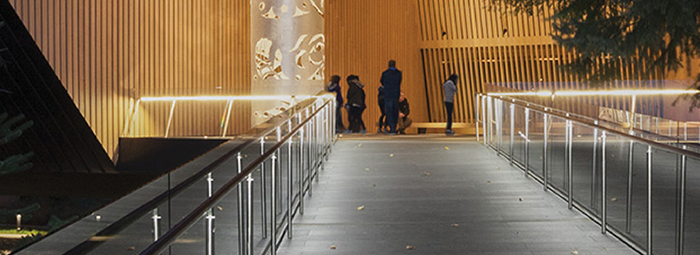
©2020 This excerpt taken from the article of the same name which appeared in ASHRAE Journal, vol. 62, no. 7, July 2020.
About the Author
Mary On is an associate at Integral Group in Vancouver, BC, Canada.
The Audain Art Museum is located on Blackcomb Way, in the resort municipality of Whistler, British Columbia, Canada. The new, two-story, Class AA museum, with a total gross area of approximately 4750 m2 (51,130 ft2), contains permanent and temporary exhibit galleries, workshops, a public lobby, a gift shop, education space, offices and a suite for a live-in building manager.
The project followed an integrated design process, with a strong focus on sustainability and the environment. As part of the project’s commitment to energy and the environment, the building was designed to target a gold rating under LEED ® Canada for New Construction and Major Renovations 2009. The main objective of this project is to house, display, and preserve the museum art collection within a secure, sustainable, energy-efficient building. The heating, cooling, ventilation, and plumbing systems must meet the following design and performance criteria:
- A stable and consistent temperature and humidity must be maintained in the space, and airborne pollutants must be filtered out, for the preservation of artwork.
- The systems must be robust and reliable with redundancy, so that continuous, 24-hour/day, 7-days/week operation is maintained.
- They must have an optimal equipment life cycle and ease of operation and maintenance, as well as life-cycle replacement.
System flexibility with independent control is needed in the temporary exhibit gallery to meet the environment requirements of traveling exhibits.
Energy Efficiency
As the building was designed to target the LEED Canada NC 2009 Gold rating, an energy model was created using eQuest 3.64 to compare the energy performance of the proposed design against an ANSI/ASHRAE/IESNA Standard 90.1-2007 baseline building. The model predicted that the proposed building’s annual energy consumption would be 1,730,575 kWh (5,900,000 kBtu), 40% less than the baseline building.
The majority of the energwy savings comes from space-heating energy reduction. The proposed building is simulated to use 368,833 kWh (1,258,500 kBtu) of space heating energy, 31% of the proposed building. Taking humidification heating energy into account, the overall heating energy saving accounts for 70% of the total energy savings. The heating energy reduction is primarily a result of a high-performance building envelope and the use of air-source heat pumps with heat recovery to generate the buildingw’s heating water needs, as well as air-to-air heat recovery wheels in air-handling units (AHUs) to recover waste heat and moisture from the exhaust air.
Building Envelope
Located in a cold-weather climate, with 4,180 heating degree-days below 18 °C (64 °F) (BC Building Code 2012), the building utilizes a high-performance building envelope to reduce envelope heat loss, thus reducing the heating energy consumption and helping to maintain a stable indoor temperature for the exhibit. The building’s envelope includes an R-55 (RSI-9.7) roof, an R-23.3 (RSI-4.1) wall, and triple-glazed windows, compared to the baseline model with an R-20 (RSI-3.5) roof, an R-15.6 (RSI-2.7) wall, and double-glazed windows.
Read the Full Article
ASHRAE Members have free access to the full-text PDF of this article as well as the complete ASHRAE Journal archives back to 1997 in the Free Member Access Area.
Non-members can purchase features from the ASHRAE Bookstore. Or, Join ASHRAE!
Return to Featured Article Excerpts
Return to ASHRAE Journal Featured Article Excerpts